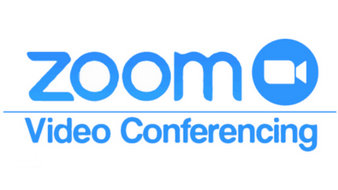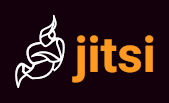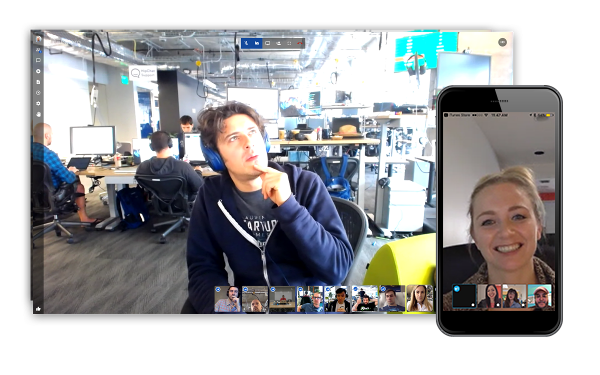 Due to working from home, a LOT of folks are using Zoom for conferencing, as well as “FreeConferenceCall”… there are security issues you need to be aware of! One really embarrassing issue is called “Zoom Bombing.” This is a take on “Photo Bombing.” Since attendees can show any video from their computer, people have taken to acquiring conference keys, connecting, and then showing porn during a conference. Since everyone in the conference then sees it, it usually “takes down” the whole conference! This happened to Chick-Fil-A recently!
Due to working from home, a LOT of folks are using Zoom for conferencing, as well as “FreeConferenceCall”… there are security issues you need to be aware of! One really embarrassing issue is called “Zoom Bombing.” This is a take on “Photo Bombing.” Since attendees can show any video from their computer, people have taken to acquiring conference keys, connecting, and then showing porn during a conference. Since everyone in the conference then sees it, it usually “takes down” the whole conference! This happened to Chick-Fil-A recently!
Using Zoom? Here are the privacy issues you need to be aware of
Protonmail – By: Richie Koch – “Zoom has seen a flood of new users as the COVID-19 outbreak forces more and more employees to transition to working from home. Zoom’s big selling point is its near-frictionless video calls.
However, new users should be aware of the company’s privacy practices. By looking through its privacy policy and some of its support documents, you quickly discover that Zoom allows your boss to track your attention during calls, shares the copious amounts of data it collects with third parties, and has already had a major security vulnerability.
We believe it’s important for our community who may be switching to Zoom in their workplace during the coronavirus outbreak to be aware of these issues, and this post looks at each of them in detail. At the end, we’ll offer some suggestions for what you can do to protect yourself while using Zoom.
Zoom knows if you are paying attention to the call
Whenever you host a call, you have the option to activate Zoom’s attendee attention tracking feature. This feature alerts the call’s host anytime someone on the call ‘does not have Zoom Desktop Client or Mobile App in focus for more than 30 seconds.’ In other words, if you are on a Zoom call and you click away from Zoom, the host of the call will be notified after 30 seconds, regardless of whether you minimized Zoom to take notes, check your email, or respond to a question on another app.
This feature only works if someone on the call is sharing their screen. It is unclear whether the attendees of a call are notified if attention tracking is being used on a call. When we tested it, the attendees did not receive any indication that their attention was being tracked.
Of course, just because you are not viewing the Zoom screen does not mean you are not paying attention or doing work. Furthermore, this feature cannot always reliably gauge if you have clicked away from the call. It only works on version 4.0 or later of Zoom apps and is not as reliable if you attend a Zoom call through your web browser rather than an app.
You should also be aware that if a host decides to record the call so it can be played later, Zoom saves a TXT file of the chat messages from the meeting and shares it with your boss. According to its support page on the subject, ‘the saved chat will only include messages from the host and panelists to all participants.’ However, it does not clarify what will happen to direct messages between attendees.
Zoom not only tracks your attention, it tracks you.
According to the company’s privacy policy, Zoom collects reams of data on you, including your name, physical address, email address, phone number, job title, employer. Even if you don’t make an account with Zoom, it will collect and keep data on what type of device you are using, and your IP address. It also collects information from your Facebook profile (if you use Facebook to sign in) and any ‘information you upload, provide, or create while using the service.’
Some of this data you enter yourself when you are signing in (for example, to join a call online, you must give your email) but much of it is collected automatically by the Zoom app.
In its privacy policy, under the entry ‘Does Zoom sell Personal Data?’ the policy says, ‘Depends what you mean by ‘sell.” To summarize Zoom’s policy, they say they don’t sell personal data for money to third parties, but it does share personal data with third parties for those companies’ ‘business purposes.’ And that may include passing your personal information to Google.
The camera hacking bug
Last year, security consultant Johnathan Leitschuch discovered that Zoom set up a local web server on a user’s Mac device that allowed Zoom to bypass security features in Safari 12. This web server was not mentioned in any of Zoom’s official documentation. It was used to bypass a pop-up window that Safari 12 would show before it turned on your device’s camera.
However, this remote web server was also not adequately secured. Pretty much any website could interact with it. The result was that Zoom allowed malicious websites to take over your Mac’s camera without ever alerting you.
This led Electronic Privacy Information Center to file an FTC complaint against Zoom, alleging that Zoom ‘intentionally designed its web conferencing service to bypass browser security settings and remotely enable a user’s web camera without the knowledge or consent of the user.’
While Zoom has since removed these remote web servers, its cavalier approach to getting user permission and its disregard for security and privacy concerns in the pursuit of convenience raise serious questions about trust.
How you can protect your data
As Zoom becomes the standard video conferencing tool, there are some steps you can take to keep your data safe.
- Use two devices during Zoom calls: If you are attending a Zoom call on your computer, use your phone to check your email or chat with other call attendees. This way you will not trigger the attention tracking alert.
- Do not use Facebook to sign in: It might save time, but it is a poor security practice and dramatically increases the amount of personal data Zoom has access to.
- Keep your Zoom app updated: Zoom removed the remote web server from the latest versions of its apps. If you recently downloaded Zoom, there’s no need to be concerned about this specific vulnerability.
We recognize that working from home is going to require a reconfiguring of how companies, offices, and employees work. However, workers’ personal privacy should not be sacrificed in this transition.
Now that offices are closed, it is more important than ever that workers remember security guidelines. We have resources that can help you stay safe. Our IT security ebook, with its email security and IT security best practices lists, can help employees maintain their security and privacy while working from home.”
 Remember, I said that Linux folk don’t care for Snap? Well, Linux Mint is based on Ubuntu Linux, BUT they are stripping all of Snap out of the new Linux Mint version 20. The beta release is out now. And, they are “protecting you” from Snap! To be fair, they are responding to the user base!
Remember, I said that Linux folk don’t care for Snap? Well, Linux Mint is based on Ubuntu Linux, BUT they are stripping all of Snap out of the new Linux Mint version 20. The beta release is out now. And, they are “protecting you” from Snap! To be fair, they are responding to the user base! Elon Musk’s StarLink “Internet Provider from Space” program is rolling out big time! So far, there are 538 operational satellites in the sky ready to provide Internet connectivity from orbit! Low orbit, to speed up latency, but orbit, nonetheless! 238 of those satellite went up last week, with 60 more to be added next week!
Elon Musk’s StarLink “Internet Provider from Space” program is rolling out big time! So far, there are 538 operational satellites in the sky ready to provide Internet connectivity from orbit! Low orbit, to speed up latency, but orbit, nonetheless! 238 of those satellite went up last week, with 60 more to be added next week! Snap, if you did not know, is Ubuntu’s attempt at a “unified standard app store” in Linux. There you go! Enough to hate on it already! Linux users are classically renegades that want to do everything the hard way, on their own! After all, how can I get true geek cred if one just goes to an “app store” and have the whatever-I-wanted-software installed by a common system? Yeeesh!
Snap, if you did not know, is Ubuntu’s attempt at a “unified standard app store” in Linux. There you go! Enough to hate on it already! Linux users are classically renegades that want to do everything the hard way, on their own! After all, how can I get true geek cred if one just goes to an “app store” and have the whatever-I-wanted-software installed by a common system? Yeeesh! You can buy the full price version for $9.99 to “unlock” and remove the watermark in the upper left hand corner of the screen. Or, use it free if you don’t mind advertising for them a bit. Simply go to your phone’s Appstore, locate iVCam and install it. That part is totally free. THEN, download and install the Windows software side, and be sure that your phone, and your PC are on the same wireless network. iVCam appears as a “regular” webcam in your streaming app, or other application (like OBS for streaming, or Skype for phone use, or maybe Zoom, or Jitsi for conferencing.)
You can buy the full price version for $9.99 to “unlock” and remove the watermark in the upper left hand corner of the screen. Or, use it free if you don’t mind advertising for them a bit. Simply go to your phone’s Appstore, locate iVCam and install it. That part is totally free. THEN, download and install the Windows software side, and be sure that your phone, and your PC are on the same wireless network. iVCam appears as a “regular” webcam in your streaming app, or other application (like OBS for streaming, or Skype for phone use, or maybe Zoom, or Jitsi for conferencing.) Zoom Conferencing has taken a lot of hits for security issues of late. And, rightly so! There is a great Open Source alternative called Jitsi, that you should look into!
Zoom Conferencing has taken a lot of hits for security issues of late. And, rightly so! There is a great Open Source alternative called Jitsi, that you should look into! What else can you do with Jitsi Meet?
What else can you do with Jitsi Meet? YouTube isn’t the only service that is trying to cut their use of Internet bandwidth to maintain their service levels. Microsoft Office 365 is being throttled as well. I expect that the strain of so many people working from home, and trying to keep up with the news is causing many services to adjust to the increased usage.
YouTube isn’t the only service that is trying to cut their use of Internet bandwidth to maintain their service levels. Microsoft Office 365 is being throttled as well. I expect that the strain of so many people working from home, and trying to keep up with the news is causing many services to adjust to the increased usage. Due to working from home, a LOT of folks are using Zoom for conferencing, as well as “FreeConferenceCall”… there are security issues you need to be aware of! One really embarrassing issue is called “Zoom Bombing.” This is a take on “Photo Bombing.” Since attendees can show any video from their computer, people have taken to acquiring conference keys, connecting, and then showing porn during a conference. Since everyone in the conference then sees it, it usually “takes down” the whole conference! This happened to Chick-Fil-A recently!
Due to working from home, a LOT of folks are using Zoom for conferencing, as well as “FreeConferenceCall”… there are security issues you need to be aware of! One really embarrassing issue is called “Zoom Bombing.” This is a take on “Photo Bombing.” Since attendees can show any video from their computer, people have taken to acquiring conference keys, connecting, and then showing porn during a conference. Since everyone in the conference then sees it, it usually “takes down” the whole conference! This happened to Chick-Fil-A recently! Right when we need it most?! Sigh!
Right when we need it most?! Sigh! If it is a respiratory disease, why is everyone hoarding toilet paper like it causes diarrhea? “Because they are crazy!?” Yep… pretty much!
If it is a respiratory disease, why is everyone hoarding toilet paper like it causes diarrhea? “Because they are crazy!?” Yep… pretty much!